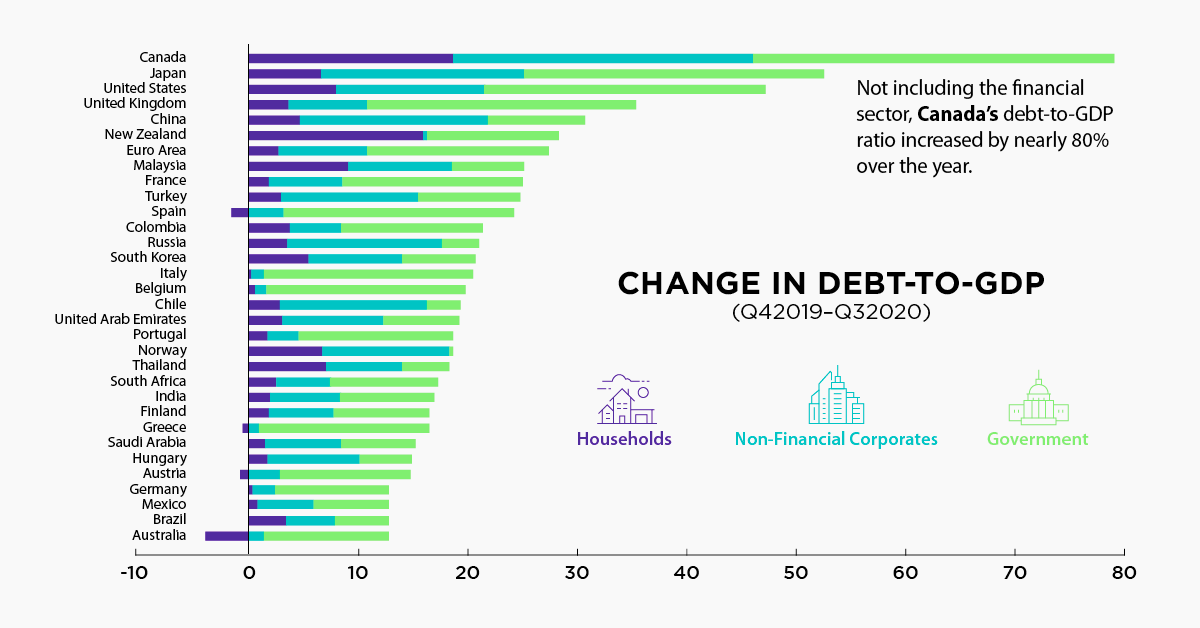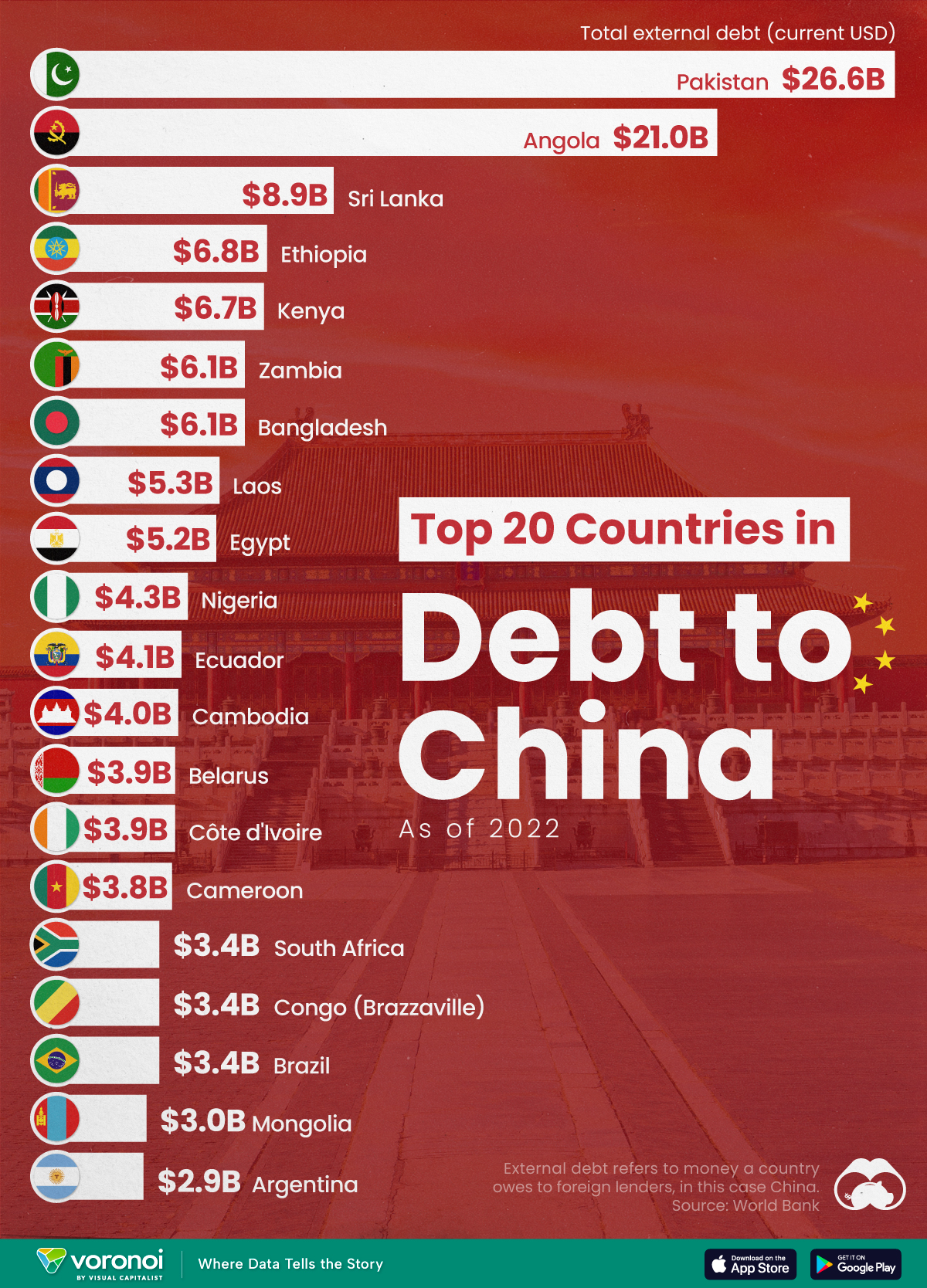Debt
Chart: Debt-to-GDP Continues to Rise Around the World
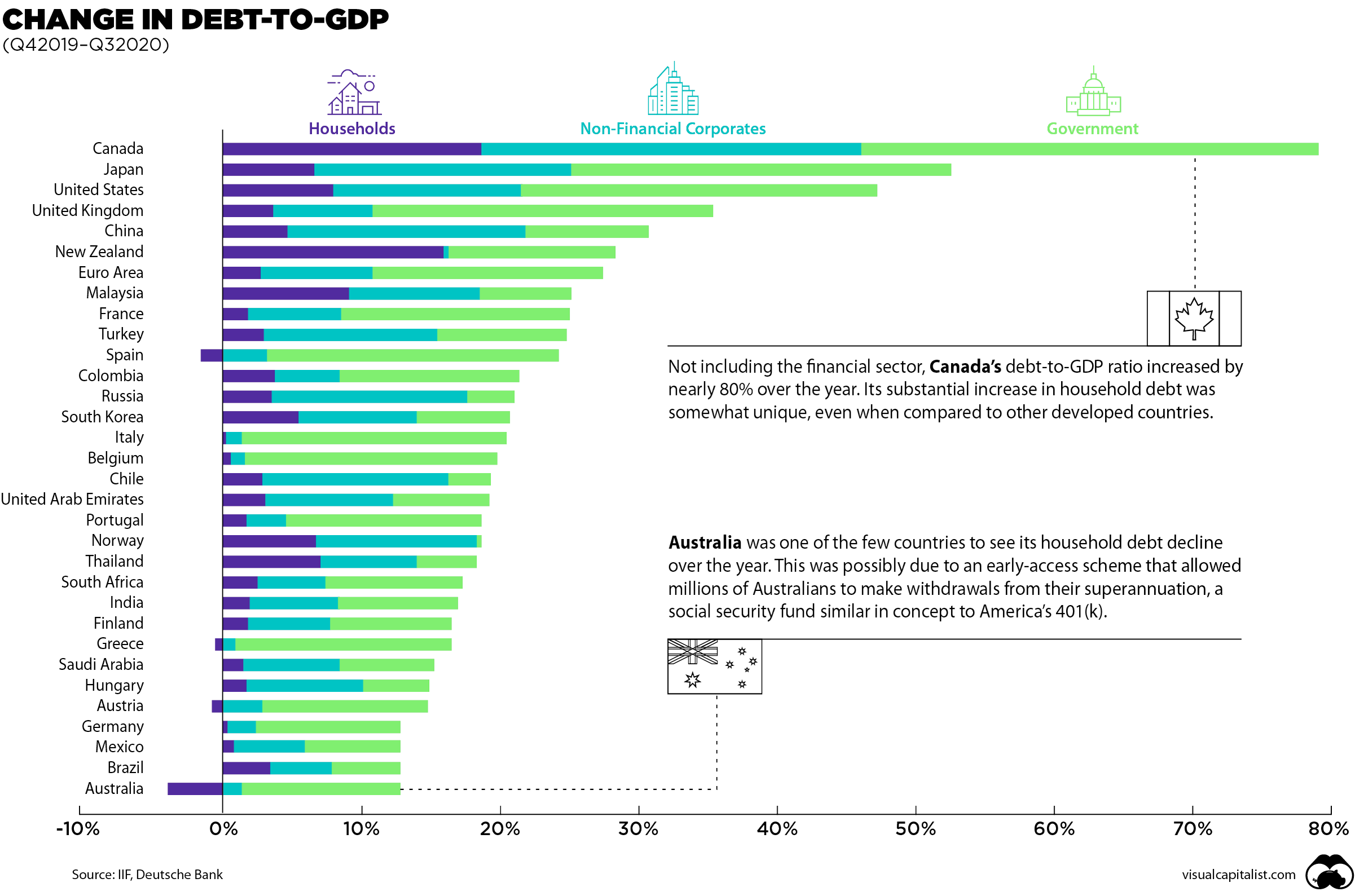
Chart: Debt-to-GDP Continues to Rise Around the World
With vaccines slowly obtaining approval in various countries, the world may finally be on the path to overcoming the COVID-19 pandemic.
The economic situation, on the other hand, is unlikely to improve anytime soon. Falling revenues combined with costly pandemic relief measures have increased global debt by $20 trillion since the third quarter of 2019. By the end of 2020, economists expect global debt to reach $277 trillion, or 365% of world GDP.
Today’s chart uses data from the Institute of International Finance (IIF) to provide an overview of where debt, relative to GDP, has increased the most.
Comparing Developed and Emerging Markets
Developed economies represent four of the five countries seeing the largest increases in debt-to-GDP, but looking from a more macro angle reveals that debt levels are rising at a similar pace around the world.
| Q3 2019 ($ trillions) | Q3 2020 ($ trillions) | % Increase | |
|---|---|---|---|
| Developed markets | $181.8 | $196.3 | 8.0% |
| Emerging markets | $70.9 | $76.4 | 7.7% |
| Global total | $252.7 | $272.7 | 7.9% |
Source: IIF, BIS, IMF, Haver, National Sources
To put these figures into perspective, economists often use the debt-to-GDP metric, which compares a country’s debt to its economic output. As the name implies, it’s calculated by taking a country’s total debts and dividing them by its annual GDP. Having a low debt-to-GDP ratio suggests that a country will have little issues paying off its debts, while a high ratio can be interpreted as a sign of higher default risk.
The actual definition of a “low” or “high” ratio is quite loose, though the World Bank believes there is a threshold for government debt at 77% of GDP. Every percentage point beyond this threshold has been found to detract 0.017 percentage points from annual growth.
Comparing Debt-to-GDP by Sector
To see how COVID-19 has affected the global economy since Q3 2019, let’s take a look at each sector’s debt as a percentage of GDP.
| Households (Q3 '19) | Households (Q3 '20) | Non-financials* (Q3 '19) | Non-financials* (Q3 '20) | Government (Q3 '19) | Government (Q3 '20) | |
|---|---|---|---|---|---|---|
| Developed markets average | 72% | 78% | 91% | 102% | 110% | 131% |
| U.S. | 74% | 81% | 75% | 88% | 102% | 127% |
| Euro Area | 58% | 61% | 108% | 114% | 102% | 115% |
| UK | 84% | 88% | 73% | 78% | 110% | 130% |
| Emerging markets average | 40% | 44% | 93% | 104% | 53% | 60% |
| China | 54% | 60% | 150% | 166% | 53% | 63% |
| Russia | 19% | 23% | 78% | 91% | 15% | 18% |
| Global total | 60% | 65% | 92% | 103% | 89% | 105% |
*Corporations that are not in the financial industry.
Source: IIF, BIS, Haver, National Sources
Within developed markets, government debt-to-GDP grew by 21 percentage points compared to 11 for non-financial corporates, and 6 for households. This is unsurprising as governments have supplied billions (or in some cases, trillions) of economic stimulus while also pulling in less tax revenue.
The story in emerging markets is slightly different, with non-financial corporates experiencing the largest increase at 11 percentage points. The sector’s debt is now at 104% of GDP, making it the most highly-leveraged in the region.
Highlights from Today’s Chart
Today’s chart boils this data down to the individual country level, allowing us to identify two outliers: Canada and Australia.
Excluding the financial sector, Canada’s debt-to-GDP ratio increased by nearly 80%, the highest of any developed country. Government borrowing surged as the Canada Emergency Response Benefit (CERB), which provided struggling Canadians with roughly $1,500 a month, rang up a bill of $60 billion over 7 months.
An increase in debt wasn’t the only reason for the country’s worsening debt-to-GDP ratios. In Q2 2020, Canada’s GDP declined at an annualized rate of 38%, its worst three-month performance on record.
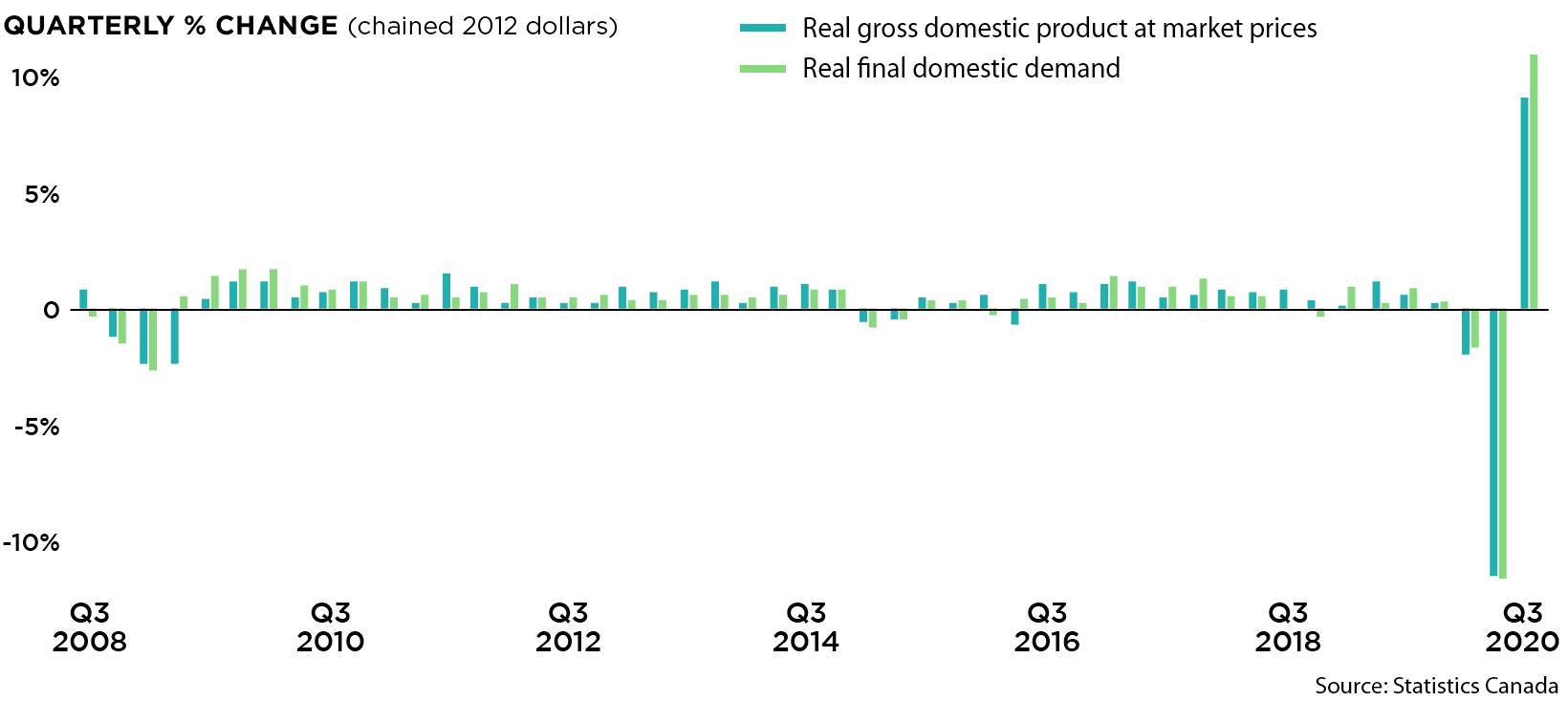
Australia was another outlier, but for a different reason; the country’s household debt decreased by almost 5% relative to GDP. This was likely due to an early-access scheme that allowed millions of Australians to make withdrawals from their superannuation, a social security fund similar to America’s 401(k).
We know that almost 60 per cent of those accessing their [superannuation] early have used it…to meet essential day-to-day expenses, including paying down debts.
—Josh Frydenberg, Treasurer of the Commonwealth of Australia
Officials have exercised caution around the prolonged use of these programs, as superannuation funds are meant to support people through retirement. Of the 2.6 million Australians that accessed their superannuations early, 500,000 are believed to have completely emptied their accounts.
Debt-to-GDP is Set to Fall…Or is it?
A global roll out of COVID-19 vaccines is likely to end the ongoing health crisis and allow the economy to return to pre-pandemic levels, though delays are to be expected.
Regardless, this spells good news for governments and financial institutions around the world—economic output will recover, shrinking debt-to-GDP ratios. Whether or not borrowing will also slow down, however, is much harder to predict.
Government borrowing has been relied on to stimulate growth since 2008, and with 75% of Americans in favor of a second COVID-19 relief bill, public debt is likely to accumulate further. Private sector debt is following a similar trend, with non-financial U.S. corporations owing $10.9 trillion as of Q2 2020, up from $6.4 trillion at the start of 2008.
These growing debts have been manageable thanks to an extended period of low interest rates and loose monetary policy, but whether or not this is sustainable remains to be seen.
Economy
Ranked: The Top 20 Countries in Debt to China
The 20 nations featured in this graphic each owe billions in debt to China, posing concerns for their economic future.
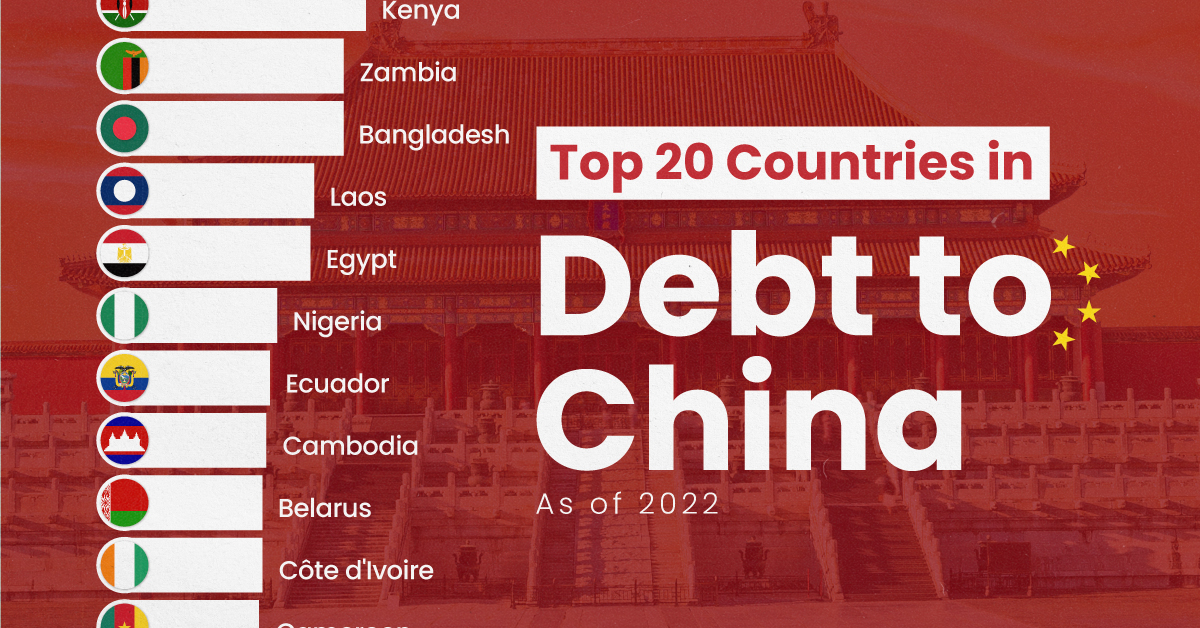
Ranked: The Top 20 Countries in Debt to China
This was originally posted on our Voronoi app. Download the app for free on iOS or Android and discover incredible data-driven charts from a variety of trusted sources.
In this graphic, we ranked the top 20 countries by their amount of debt to China. These figures are as of 2022, and come from the World Bank (accessed via Yahoo Finance).
The data used to make this graphic can be found in the table below.
| Country | Total external debt to China ($B) |
|---|---|
| 🇵🇰 Pakistan | $26.6 |
| 🇦🇴 Angola | $21.0 |
| 🇱🇰 Sri Lanka | $8.9 |
| 🇪🇹 Ethiopia | $6.8 |
| 🇰🇪 Kenya | $6.7 |
| 🇧🇩 Bangladesh | $6.1 |
| 🇿🇲 Zambia | $6.1 |
| 🇱🇦 Laos | $5.3 |
| 🇪🇬 Egypt | $5.2 |
| 🇳🇬 Nigeria | $4.3 |
| 🇪🇨 Ecuador | $4.1 |
| 🇰🇭 Cambodia | $4.0 |
| 🇨🇮 Côte d'Ivoire | $3.9 |
| 🇧🇾 Belarus | $3.9 |
| 🇨🇲 Cameroon | $3.8 |
| 🇧🇷 Brazil | $3.4 |
| 🇨🇬 Republic of the Congo | $3.4 |
| 🇿🇦 South Africa | $3.4 |
| 🇲🇳 Mongolia | $3.0 |
| 🇦🇷 Argentina | $2.9 |
This dataset highlights Pakistan and Angola as having the largest debts to China by a wide margin. Both countries have taken billions in loans from China for various infrastructure and energy projects.
Critically, both countries have also struggled to manage their debt burdens. In February 2024, China extended the maturity of a $2 billion loan to Pakistan.
Soon after in March 2024, Angola negotiated a lower monthly debt payment with its biggest Chinese creditor, China Development Bank (CDB).
Could China be in Trouble?
China has provided developing countries with over $1 trillion in committed funding through its Belt and Road Initiative (BRI), a massive economic development project aimed at enhancing trade between China and countries across Asia, Africa, and Europe.
Many believe that this lending spree could be an issue in the near future.
According to a 2023 report by AidData, 80% of these loans involve countries in financial distress, raising concerns about whether participating nations will ever be able to repay their debts.
While China claims the BRI is a driver of global development, critics in the West have long warned that the BRI employs debt-trap diplomacy, a tactic where one country uses loans to gain influence over another.
Editor’s note: The debt shown in this visualization focuses only on direct external debt, and does not include publicly-traded, liquid, debt securities like bonds. Furthermore, it’s worth noting the World Bank data excludes some countries with data accuracy or reporting issues, such as Venezuela.
Learn More About Debt from Visual Capitalist
If you enjoyed this post, check out our breakdown of $97 trillion in global government debt.
-

 Technology6 days ago
Technology6 days agoVisualizing AI Patents by Country
-

 Green2 weeks ago
Green2 weeks agoRanking the Top 15 Countries by Carbon Tax Revenue
-

 Markets2 weeks ago
Markets2 weeks agoU.S. Debt Interest Payments Reach $1 Trillion
-

 Mining2 weeks ago
Mining2 weeks agoGold vs. S&P 500: Which Has Grown More Over Five Years?
-

 Uranium2 weeks ago
Uranium2 weeks agoThe World’s Biggest Nuclear Energy Producers
-

 Misc2 weeks ago
Misc2 weeks agoHow Hard Is It to Get Into an Ivy League School?
-

 Debt2 weeks ago
Debt2 weeks agoHow Debt-to-GDP Ratios Have Changed Since 2000
-

 Culture2 weeks ago
Culture2 weeks agoThe Highest Earning Athletes in Seven Professional Sports

